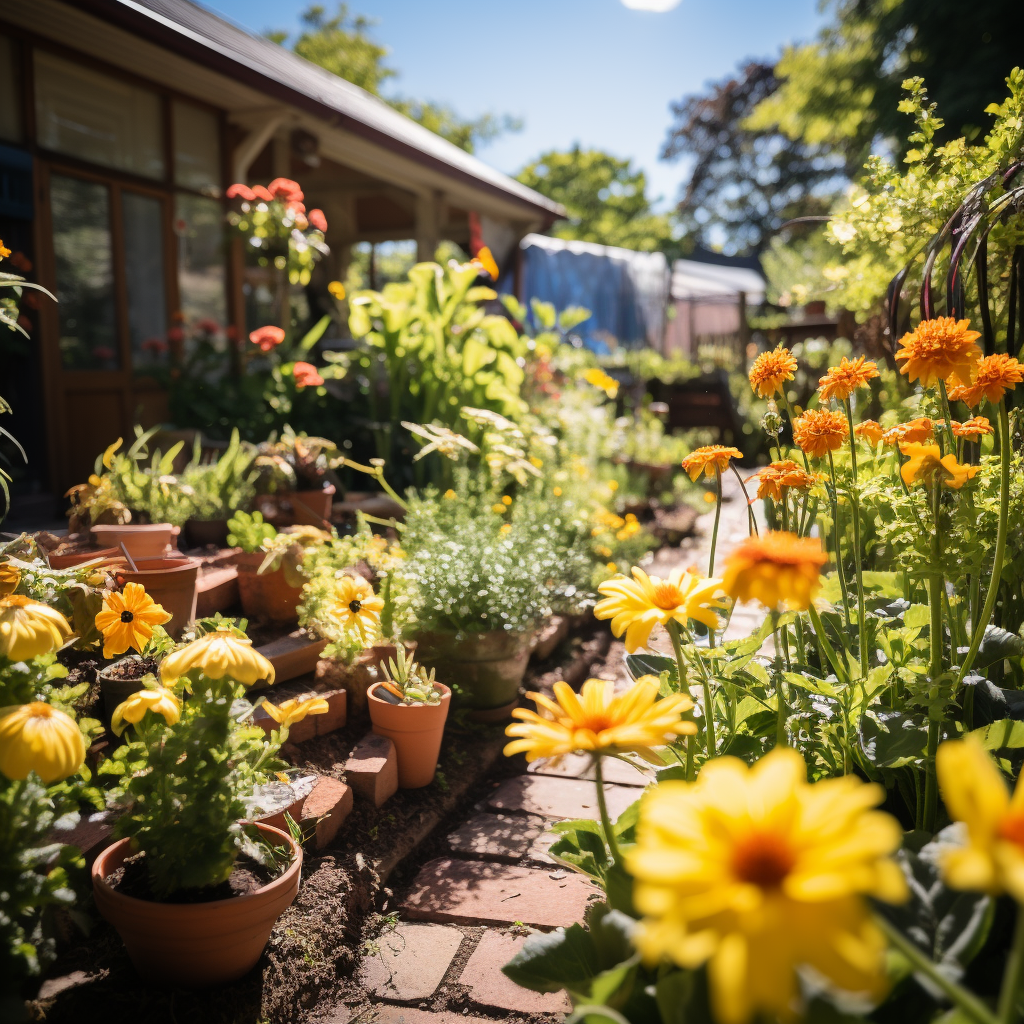Unlocking the Magic of Turmeric: 6 Gardening Benefits and Tips
Pay extra attention to areas where ants tend to gather, and sprinkle a little extra turmeric love there.
Ant Repellant Turmeric’s Natural Ant Repellent
Hey there, fellow garden enthusiasts! 🌼 It’s Gayle from Gardener Whisperer Tips, and today, we’re diving into the fantastic world of turmeric and its magical powers in your survival garden.
Ants Beware! 🐜 You know, sometimes those pesky ants can really be a bother in your garden haven. But here’s where our golden friend, turmeric, comes to the rescue!
How to Use Turmeric to Get Rid of Ants Just a Pinch Will Do No need for chemical solutions that harm our green friends. Simply grab some turmeric powder, and with just a few pinches, create a natural ant-repelling barrier around your plants. 🌱
Protect Your Garden This gentle but effective spice emits a strong odor that ants can’t stand, ensuring your garden stays ant-free. It’s like a garden guardian that cares as much as you do.
And here’s a pro-tip: Pay extra attention to areas where ants tend to gather, and sprinkle a little extra turmeric love there.
Mealybugs and Ants: An Unwanted Alliance Oh, and did you know that ants and mealybugs sometimes team up? It’s true! Ants carry mealybugs to our plants in exchange for their sweet honeydew. So, keeping ants away means fewer mealybug troubles. Double win! 🐜🌿

Soil Pest Control
Fighting Soil Pests with Turmeric
Welcome back, dear garden friends! 🌱 It’s Gayle, your gardening companion from Gardener Whisperer Tips, and we’re about to dig deeper into the incredible benefits of turmeric for your survival garden.
Nurturing Your Soil Health 🌿
Now, let’s chat about something every gardener cares deeply about—soil health. It’s the very foundation of our green sanctuaries, and turmeric has a role to play here too.
Defeating Fungal Root Rot and Fungus Gnats
The Turmeric Solution
Have you ever battled with fungal root rot or pesky fungus gnats in your soil? If so, turmeric is your secret weapon. It’s like your garden’s immune booster!
How to Use Turmeric for Soil Pest Control
The Right Ratio
When preparing your potting mix or repotting a plant, remember this golden rule: one tablespoon of turmeric per gallon of soil. It’s enough to keep those soil pests in check without harming the helpful soil microbes.
For Non-Repotting Situations
If repotting isn’t an option, don’t worry! Mix one tablespoon of turmeric in one gallon of water (or one teaspoon per liter) and give your affected plant a thorough soak with this solution. It’s like a healing bath for your plants.
Pro-tip: Ensure thorough coverage, and you’ll see those soil pests scurry away. 🌱
Healing Tree Wounds Nurturing Your Plants with Turmeric
Hello again, gardening pals! 🌻 It’s your friendly guide, Gayle, from Gardener Whisperer Tips. Today, we’re delving into the compassionate side of gardening and how turmeric can help heal our beloved plant friends.
A Plant’s Ailments 🌿 Just like us, plants can suffer from wounds and injuries. When they do, it’s our duty as gardeners to come to their rescue.
Turmeric: Nature’s Healing Agent Harnessing Turmeric’s Natural Powers Turmeric isn’t just about spicing up our dishes; it’s also a remarkable natural antiseptic. Its antibacterial properties make it a trusted remedy for various types of plant wounds, helping them recover and flourish once more.
How to Use Turmeric for Healing Wounds A Plant’s First Aid Kit In case of plant injuries, whip up a simple turmeric paste and gently apply it over the wounded area. It’s like giving your plants a soothing bandage, and they’ll thank you for it.
For Stem or Branch Fractures For more severe wounds, like stem or branch fractures, apply the turmeric paste and carefully secure the affected area with a polythene wrap or grafting tape. It’s like a cast for plants!
A Gardener’s Duty Remember, as gardeners, it’s our duty to protect and nurture our plants, and turmeric is a loving companion in this journey.
Treating Rose Dieback Disease
Defeating Rose Dieback with Turmeric
Greetings, passionate gardeners! 🌹 Gayle from Gardener Whisperer Tips here, and today we’re tackling a common gardener’s challenge: rose dieback disease. But fret not; turmeric has a remedy for our beloved roses!
Understanding Rose Dieback 🥀
Rose dieback can be a gardener’s nightmare, and it’s something many of us have encountered. This condition causes browning or blackening of the rose stem or branches, slowly engulfing the entire plant if left untreated.
Turmeric’s Healing Touch
Turmeric Paste to the Rescue
Turmeric’s natural antiseptic and antibacterial properties come to the rescue once again. It’s a plant’s best friend when it comes to healing wounds and preventing the progression of dieback disease.
How to Treat Rose Dieback with Turmeric
A Saving Grace for Roses
If you spot dieback affecting your roses, act swiftly. Apply a turmeric paste over the affected area after pruning. This simple step can halt the disease in its tracks and save your precious roses.
Branch Dieback or Main Stem Dieback
Whether it’s branch dieback or the main stem that’s affected, turmeric’s healing power is there for you. Just apply the paste and secure the area with polythene or grafting tape. It’s like giving your roses a protective hug.
Garden Guardian 🌼
Turmeric isn’t just a spice; it’s a guardian for your garden. Your roses will thank you for this nurturing touch.
Turmeric as a Rooting Agent
Boosting Rooting Chances with Turmeric
Hello, green thumbs! 🌱 Gayle from Gardener Whisperer Tips is back with more insights to make your garden flourish. Today, we’re talking about how turmeric can be your ally in the delicate process of rooting plant cuttings.
Rooting Success with Turmeric 🌿
When it comes to propagating new plants from cuttings, success can be a bit elusive. But don’t worry, turmeric is here to boost your chances!
The Power of Turmeric
Anti-Microbial and Anti-Fungal Effects
Turmeric’s natural properties include being anti-microbial and anti-fungal. These qualities create an environment conducive to root growth.
How to Use Turmeric for Rooting Plant Cuttings
Your Plant Cuttings’ Best Friend
Before you start, mix a small amount of turmeric into the soil you’ll be using for your cuttings. It’s like giving your new plants a protective shield.
A Pro Tip for Success
Ensure your cuttings receive the right amount of light, humidity, and care, and watch them thrive with the help of turmeric’s magic touch. 🌱✨
Pesticide Spray
Turmeric-Powered Pest Control
Welcome back, fellow gardeners! 🌼 Gayle from Gardener Whisperer Tips here, and we’re about to uncover the natural pesticide potential of turmeric. It’s time to protect our garden from pests and diseases the organic way.
Turmeric: Your Pest Control Partner 🌱
While turmeric might not wear a cape, it’s a superhero in the garden when it comes to battling fungal diseases and certain pests. Say goodbye to powdery mildew and more!
Turmeric for Minor Fungal Spots
Creating a Powerful Solution
For minor fungal spots and that pesky powdery mildew, create a mixture of 2 teaspoons of turmeric powder in 1 liter of water. This simple spray can work wonders against these garden nuisances. It’s like a gentle warrior for your plants. 🌿🌼
A Powerful Natural Remedy
Turmeric, Milk, and Vinegar Mix
For the most robust defense against powdery mildew, mix 2 teaspoons of turmeric powder, 100 ml of milk, and 2 teaspoons of distilled white vinegar into 1 liter of water. This is nature’s most potent remedy for powdery mildew.
Enhancing Neem Oil with Turmeric
The Ultimate Pest Control
If neem oil alone isn’t doing the trick against stubborn pests like mealybugs, aphids, and mites, we’ve got a solution. Mix 5 to 10 ml of neem oil in 1 liter of water, add 1–2 teaspoons of turmeric powder (or fresh turmeric rhizome), and toss in 4 to 5 crushed garlic cloves. Sieve the mixture to avoid clogging your spray bottle.
A Word of Caution
Remember, always do a patch test on a leaf, especially if you’re trying a new concentration of neem oil. It’s all about finding the right balance for your garden’s needs.
Your Garden’s Protector 🦸♂️
Turmeric, together with a few other ingredients, can create a formidable defense against garden pests and diseases. Your garden will thrive under this care.
Wrap-Up
Please, don’t forget to like, share, and comment with your questions and feedback. Together, we’re creating healthier, happier gardens. No need to go anywhere; all sections are right here on this page.
That’s it for our sixth gardening tip with turmeric! 🌼
Amazon and the Amazon logo are trademarks of Amazon.com, Inc, or its affiliates.AMAZON AFFILIATE DISCLOSURE The Garden Whisperer Tips blog is a participant in the Amazon Services LLC Associates Program, an affiliate advertising program designed to provide a means for sites to earn advertising fees by advertising and linking to Amazon.com. As an Amazon Associate, we earn from qualifying purchases. Some of the links on this blog are affiliate links, and if you go through them to make a purchase, we will earn a commission at no extra cost to you. AFFILIATE MARKETING AND ADVERTISEMENT TRANSPARENCY At Garden Whisperer Tips, we believe in full transparency with our readers. We participate in multiple affiliate marketing programs, and some of the links on this blog may be affiliate links. This means we may earn a commission if you click on the link or make a purchase using the link. We also host advertisements on our blog, which helps us generate revenue. Rest assured, our editorial content is not influenced by advertisers or affiliate partnerships.





